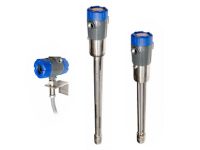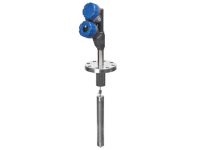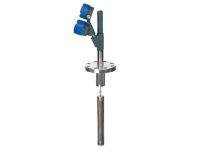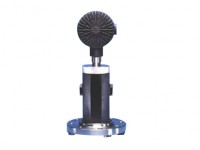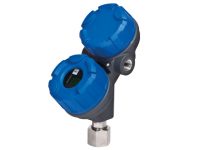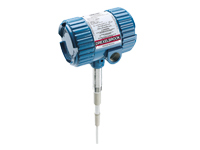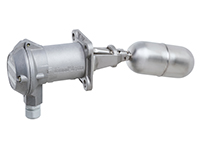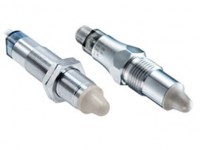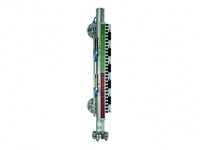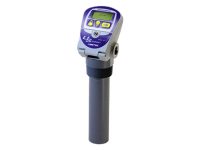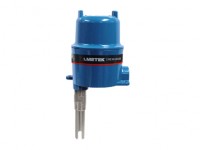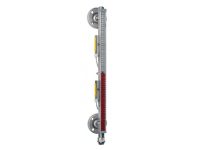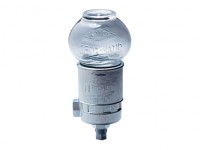Level Measurement
ABLE Instruments & Controls offer an extensive range of level measurement products including level gauges, level indicators, level sensors & level switches.
To assure the safety and profitability of processes, it is essential to be equipped with instruments providing reliable and precise measurements of level. At the basics of level measurement, it is simply about determining the position of a surface inside a tank, reactor or other vessel. More precisely, level measurement is the determination of the linear vertical distance between a reference point (usually the base of a holding container) and the surface of either a liquid, the top of a solid, or the interface of two liquids. Precise control of the level of liquid in a tank, reactor, or other vessel is important in many process applications.
Please choose the product below that best suits your needs or call us on +44 (0) 118 9311188 for more help.
Level measurement is often used for inventory management. To provide good control, accurate measurement is essential, and several devices and systems are available for measuring product level. Each is designed to provide accurate level measurement, although measurement precision and principles of operation vary among devices. All level measurements involve interaction between a sensing device, element, or system and a product inside a holding container.
The following text will introduce the most common reasons for measuring level and explain why and how the different technologies for level measurement work. It will cover important aspects to consider when selecting a level-measurement device or system for a particular application, as well as the benefits and limitations of level measurement products.
Why measure level?
1.Inventory
The main reason for measuring level is to keep track of inventory in terms of volume or weight.
The industry has however increased its demands on control of inventory. Level measurement is one key component in a tank gauging system for reliable and accurate inventory control. Other measurements for inventory control are temperature, pressure and water level. Keeping good control over your inventory has become increasingly important over the last several years, not only for operators using the content in a storage vessel, but for the whole company, including company executives, accounting, loss and leakage control managers and others. This is a result of increased focus on safety, cost of ownership and the value of products stored. It is common to see level accuracy requirements being better than -1/8 inch (3 mm).
2. Custody transfer
In many instances, the amount of material that is bought and sold (custody transfer) is based on a level measurement converted into volume or weight (from mathematical equations or strapping tables. In custody transfer situations, the required accuracy of the level instrument is very high, since even an error of 1/8 inch (~3mm) of measured level in a large tank can result in a significant error in terms of uncertain volume.
There are two main types of Custody transfer, Legal and Commercial. The Commercial Custody transfer occurs when two parties agree upon the required volume accuracy of the measurement and what instruments to use. The Legal Custody transfer is more stringent and requires metrologically approved instruments. Such instruments have a Legal pattern approval to be used for such use and typically have accuracy better than 1/16 inch (1 mm).
3. Process efficiency
Accurate level measurement increases efficiency. For example, if a tank farm needs to keep a certain amount of material available at all times and the storage tanks are not filled to full capacity, the facility will incur the unnecessary expense of purchasing and maintaining additional storage vessels. The storage tanks could hold another 60 units of product before the farm would need to purchase a new tank. Efficient use of storage space prevents the extra cost of needlessly acquiring more storage vessels.
4. Safety
Level is also measured for safety reasons. Filling vessels above their capacities can cause safety hazards—spills (overflowing) in open vessels. If the vessels are holding caustic, reactive, hot, flammable, or hazardous materials, spills or overpressure could lead to catastrophic results. Monitoring levels in tanks to make sure they are not leaking is also important for the same types of hazardous materials. Preventing overfills and leak detection is also important for meeting environmental regulations.
Types of Level Measurement Sensor
Integral to process control in many industries, level measurement sensors fall into two main types. Point level measurement sensors are used to mark a single discrete liquid height–a pre-set level condition. Generally, this type of sensor functions as a high alarm, signalling an overfill condition, or as a marker for a low alarm condition. Continuous level sensors are more sophisticated and can provide level monitoring of an entire system. They measure fluid level within a range, rather than at a one point, producing an analog output that directly correlates to the level in the vessel. To create a level management system, the output signal is linked to a process control loop and to a visual indicator.
Level measurement is an extremely strong suite for ABLE. With an extensive level instrument portfolio and a specific department dedicated to assisting the customer in making the correct selection for the application in question, ABLE are well positioned to solve any level measurement problem.
Radar
The use of radar level measurement devices is growing because of their accuracy, user focus on safety, and low maintenance requirements. Low total cost of ownership, ease of use, higher accuracy, and competitive pricing make radar level measurements an attractive value proposition for users.
These transmitters use radio wave emissions. Usually, radar fill level transmitters are mounted at the top of a tank filled with a liquid. The transmitter sends a radar signal into the liquid and receives a reflection of the signal in return. These transmitters then assess the current fill level of the tank depending upon the time taken by the transmitted signal to return. If the time required to receive the signal is more, then it means that the distance between the sensor and the liquid is more. This points to the conclusion – the liquid level in the container is less. Radar can be highly accurate, is immune to most vapours / physical characteristics of the measured media, other than, in some cases, dielectric constant.
Two of the most commonly used types of radar transmitters on the market today are Guided Wave Radar and Non-Contact (pulse) Radar. Guided Wave Radar (GWR) uses a probe to guide high frequency, electromagnetic waves as they travel down from a transmitter to the media being measured. Non-Contacting Radar sends down an electromagnetic wave through the air, it then reflects off the media and returns back to the device. Some of the advantages associated with the use of radar are high accuracy (±0.5mm for Pulse and ±0.2 mm for GWR), non-contact (Pulse), precision independent of dielectric constant, density and conductivity, and no need for re-setup when changing liquid media. GWR will exhibit some tolerance of foam and can be used for interface measurement.
When identifying potential pitfalls associated with the use of radar sensors, one should consider blocking distance, tank design (false reflections), turbulent surfaces and minimum dielectric constant, both of which can result in a loss of signal.
Pulse Burst vs. Guided Wave Radar (GWR)
Pulse Burst Radar accurately and reliably measures a wide range of media in a broad range of process conditions, from calm product surfaces and water-based media to turbulent surfaces and aggressive hydrocarbon media. As a non-contact device, Pulse Burst Radar is not susceptible to the complications that can arise whenever a probe is in contact with the process media, such as coating by viscous media or corrosive attack due to aggressive chemicals. The greater the measuring range, the more does radar prove itself to be the economical solution, given the cost of extended probe lengths. Radar is virtually unaffected by temperatures, pressures, the presence of vapours, or air movement within a vessel’s free space. Changes in specific gravity, conductivity, or dielectric constants also have no effect on measurement accuracy. As a 100% electronic instrument, the absence of moving parts translates into low maintenance costs; and, being a two-wire, loop-powered device, power requirements and installation are vastly simplified.
Pulse radar transmitters are able to accurately measure both liquid and solid media. They are very cost efficient and easy to use. Since the probe does not need to come in contact with the media, it is great for industries such as food and beverage, medical, chemical and petrochemical, and oil and gas. Typical applications include corrosive or non-corrosive liquid level monitoring, sanitary environments, caustics, small tank or process vessel, silos, and tote tanks.
Guided Radar level transmitters work with high-frequency radar pulses which are guided along a probe. As the pluses impact the medium surface, the characteristic impedance changes and part of the emitted pulse is reflected. The time between pulse launching and receiving is measured and analysed by the instrument and constitutes a direct measure for the distance between the process connection and the product surface. The sensor can output the analysed level as a continuous measurement reading through its analog output, RS-485 communications output, or optional switching output depending on output options required. GWR technology also has the ability to measure a liquid interface. A liquid interface is the ability to detect the top liquid level of the media as well as the “interface level” or level of the media that is below the liquid level, which contains a different dielectric property or physical property than the top liquid level being measured. A typical application would be an oil and water interface, in which the oil being of a lighter specific gravity and lower dielectric than water would be measured as the top liquid level and the water would be the interface level.
Magnetrol
ABLE are exclusive UK & Ireland distributors for the world-renowned Magnetrol range of level measurement instrumentation. Their product portfolio is both extensive and innovative and has applications across the process industries. Whilst Magnetrol boast a proven range of displacers, magnetic level gauges and ultrasonics, it’s their radar gauges, and particularly the flagship Eclipse® 706 GWR, that have cemented their position as the market leader in this field.
The Eclipse 706 is a loop-powered, 24 VDC level transmitter with the best-in-class Signal-to-Noise Ratio. Its advanced diagnostics, including pro-active build-up detection, automated echo curve capture and SIL2 certification make it the clear market leader.
RF Admittance Technology
The RF admittance-level sensor uses pulsed radio frequency waves to determine when material or liquid is touching the end of its probe. Since this type of sensor uses the change in dielectric to determine the level of a liquid or granular solid material, it is also called a capacitance-level sensor. The circuitry in the top of the sensor produces pulsed radio frequency waves that flow through the probe to the tank wall or the bottom of the tank, which provides a ground for the circuit. This means that the probe must be strategically located in close proximity to the outside wall or to the bottom of the tank so that the amount of dielectric in the air between the probe and the tank wall is known. If the bottom of the tank is used as the ground plane, the amount of capacitance between the probe and the level of the liquid or solid granular material will change as it rises and moves closer to the probe. The change of capacitance can continue to be measured as the material or liquid begins to cover the probe. If the side of the tank is used, the probe will use the side as the ground plane reference and it can also continue to determine the change of capacitance as the liquid moves up the probe. In both applications the dielectric of each type of liquid or material can be measured, and the probe can be calibrated to show the precise level of liquid or granular material as it gets closer to the probe or moves up on the probe.
RF Admittance is one of the most versatile technologies available providing both point and continuous level measurements. It operates on the principles of capacitance, but advances the technology by employing a patented CoteShield™ circuitry. This enables RF Admittance products to ignore the effect of process material coating on the sensing element. RF Admittance is unaffected by temperature, pressure, or density changes in the process material. This technology works well on a wide range of liquids, slurries and solids applications for industrial and municipal markets. It has demonstrated proven reliability on some of the most severe services and difficult applications. With the proper sensing element, it is ideal technology for corrosive, agitated, high pressure/temperature, and cryogenic environments. It is a technology that allows you to measure applications where foam and vapours are present and is an excellent choice for interface measurements. RF Admittance products will provide many years of maintenance free, exceptional performance.
Ametek Drexelbrook
The coating rejection capability of the Drexelbrook RF Admittance level technology is key to its success in the measurement of highly viscous media. Drexelbrook’s patented, proven Cote-Shield™ technology is able to ignore coating build-up on the probe ensuring accuracy and reliability with the elimination of false trips, regardless of product accumulation on the level transmitter.
This makes Drexelbrook level transmitters ideally suited for level measurement in applications involving adhesives, bitumen (asphalt), cement, tarmac, pitch & resins. Furthermore, other features such as its remote electronics ensure immunity to the high temperatures, pressures and significant vibration that are often associated with these manufacturing processes.
A great deal of ABLE’s reputation for level measurement expertise and problem solving was built on the Ametek Drexelbrook RF Admittance technology, part of ABLE’s level canon since the company’s inception in 1985. ABLE has enjoyed great success, supplying Drexelbrook product into the power, chemical, steel, pulp & paper and food and beverage industries.
With premier products such as the Intellipoint and Z-Tron IV point level switches and the Universal IV continuous level transmitter, the Drexelbrook range, with its versatility and immunity to process changes, constitutes a very important part of the ABLE level product portfolio.
Conclusions
Changes in temperature, pressure, density, dielectric constant or the measured material are just a few parameters that affect the choice of level measurement technology. Agitation, foaming, corrosive properties, dust and construction of the tank also influence the choice. Another factor can be the desire to use a single type of instrument for all level measurements. Finally, the selection also depends upon unit price, lifecycle cost, ease of mounting, maintenance, accuracy, relevant certifications, and the ease of integrating the device into the control system.
Key Drivers
The growing cost of labour and the increasing demand for uninterrupted production are spurring interest in electronic measurement technologies. Their design, which involves no moving parts and features built-in diagnostics, results in reduced maintenance costs and higher reliability. Electronic measurement technologies also provide significantly lower lifecycle costs than traditional mechanical and electromechanical level instruments.
The level measurement technologies featured above are sometimes referred to as:
Frequency Modulated Continuous Wave (FMCW) Radar; Time of Flight Radar; Microwave Radar; Pulse Radar; CW Radar; Free Space Radar; Tank Gauging Radar;
RF Capacitive Level Sensors, Radio Frequency Level Sensors; Admittance Level Sensors
